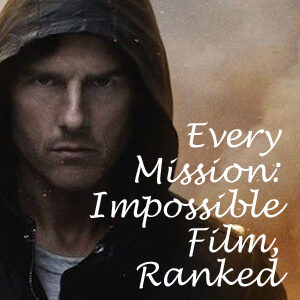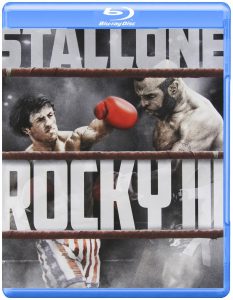Are the “Rocky” films more spectacle or substance? At first blush, the opening act of “Rocky III”(1982) suggests spectacle. Rocky fights professional wrestler Hulk Hogan – OK, technically “Thunderlips” – in a charity bout. It’s unclear to both Rocky and the viewer whether Thunderlips is putting on a show or actually trying to beat the crap out of Rocky.
When Thunderlips poses for a photo with the Balboa family immediately after the fight, one would think it was indeed a show. But 1982 was the heyday of professional wrestling holding an official stance of being real, so “Rocky III” never explicitly says it was a fake fight. That’s actually rather meta, as the “Rocky” franchise is itself an exercise in getting audiences worked up over scripted cinematic boxing matches (and “Rocky III” does that as effectively as ever with the Lang-Balboa bouts).
There is some meat on the bones of “Rocky III,” but the film (purposely) takes a while to find it. There is a lot of fakeness to sift through. Rocky doesn’t look like himself anymore; he (and Sylvester Stallone) got his face straightened out between the second and third movies. Rocky’s lived-in but handsome look is replaced with polished glamour. He has gone from dirt poor (“Rocky”) to blue-collar middle class (“Rocky II”) to flat-out rich (“Rocky III”). Between films, he learned how to read cue cards smoothly, and he’s a successful pitchman. He has defended his heavyweight title 10 times. We learn all this in a montage.
With a confidence teetering toward an ego, Rocky is less likable than when he was an underdog. He has completely taken up the position of the first film’s Apollo Creed. Now Rocky is the coasting champ and Clubber Lang (Mr. T) is the rising southpaw, like Balboa was six years prior. Rocky’s training sessions are ballroom media events where he’s interrupted by autograph seekers, whereas Lang trains alone in a ratty gym. It’s no wonder Lang easily defeats Balboa in their mid-film fight, especially when one throws in the fact that Rocky has limited vision in his right eye, the side from which Lang’s vicious power punches come.
Rocky’s eye problem – a central issue of “Rocky II” — is never mentioned in “Rocky III.” (A popular fan theory is that in addition to plastic surgery, Rocky also had eye surgery between films.) Also set aside is the concept that each fight has the potential to be fatal for the 34-year-old because of the dangers of taking so many blows to the head. Granted, Mickey does predict Lang will kill Rocky, but coming from someone who espouses crapping thunder and knocking people’s blocks off, it’s not clear when we’re supposed to take him literally.
I think at this point we’re just supposed to accept that Rocky has a uniquely rock-hard skull that functions as a helmet for his brain. Indeed, in his second fight with Lang, Rocky’s strategy is to simply let his opponent pound on his skull until he tires himself out. To be fair, the “Rocky” series at this point hasn’t explicitly said that Rocky’s mental slowness comes from his choice of career, but the danger of boxing is such a prominent subtext of “Rocky II” that it’s strange to have it totally dismissed this time around.

The franchise has the spectacle down to a science, though. The fight choreography moves further away from realism, but it is at the same time more entertaining than ever as Mr. T rains massive swats and both fighters’ blows land with blasts from the foley artists.
While Clubber Lang is in Rocky’s old shoes from a boxing perspective, he’s the opposite of Rocky in terms of personality and outlook on life, and that’s ultimately his undoing. Lang is a ball of anger who thinks he can do everything on his own. Asked about his strategy by a reporter, Clubber says he doesn’t need one. Even Lang’s ringside team just mirrors his seething face. Win the match by being meaner and angrier.
Having lost his Yoda – Mickey — in a death scene that probably had more grown men crying in the early ’80s than the actual Yoda’s death scene a year later in “Return of the Jedi,” Rocky has to relearn how to accept help. It’s especially hard when he discovers that Mickey was perhaps protecting him by scheduling past-their-prime fighters for the 10 title defenses (it’s one of the neatest layers to Mickey’s character, even though we learn about it after his death).
Like so many of us, Rocky is the type of guy who will appreciate a compliment for 5 seconds but will let criticism fester for 5 years. Everyone can see he has nothing left to prove, but he believes otherwise, and as such we get one more “one last fight” (which won’t be the last “one last fight,” of course). Surprising willpower was the key to the “Rocky” draw; trickery helped in the “Rocky II” win. Quickness is the strategy in “Rocky III,” and this is where outside assistance comes in. Rocky learns – as Paulie puts it in rather un-P.C. fashion – the “colored” style of fighting from Apollo.
(By the way, Burt Young is still entertaining as Paulie, but the actor could’ve benefitted from an arc that went beyond just being pissed at Rocky for not giving him a job and then being a content curmudgeon when Rocky finally does hire him as an assistant. For someone who has earned his world-weariness, Paulie sure acts like a baby. His financial status is also unexplained: He seems to be doing well in “Rocky II,” now he’s in the dumps at the start of “Rocky III.”)
In light of the fact that the upcoming seventh film is about Creed’s son, “Rocky III” is notable for the development of Apollo. More than in the first two entries, Carl Weathers gets to play a fully formed man, rather than a showman. The film – unavoidably predictable in the ring scenes – gives us something to wonder about when Apollo keeps telling Rocky he’ll owe him a favor for serving as his trainer on Lang-Balboa II.
It turns out the favor is a rubber match in the Creed-Balboa series, only this time it’s in Mick’s old gym with no spectators. “Rocky III” gives us a hint as to why Apollo retired when he tells his fellow radio commentators during Balboa-Lang I that hungry fighters like Lang are the reason he now sits outside the ring. Contradicting the notion that he can no longer stand toe to toe with the likes of Rocky or Clubber, Creed trains Balboa to defeat Lang, then fights Rocky himself without head protection or nearby doctors (and as the final freeze-frame shot shows us, neither is pulling their punches).
It seems Apollo feels the same thing that Rocky admitted to in “Rocky II”: He loves boxing, he’s a boxer, and therefore he’s going to box. For Rocky, family comes first, but he can’t eliminate boxing from his life. For Apollo, it’s now clear that boxing ranks above self-promotion (because really, Balboa-Creed III would’ve been a massive moneymaker, especially considering that the series was tied at one apiece), and possibly even above family. Certainly, Apollo is tight with his gym buddies, his trainer and now with Rocky, but in “Rocky III” we don’t see Apollo’s wife and two kids (who were briefly seen in “Rocky II”; neither of those kids is the seventh film’s Adonis, if you’re wondering).
Apollo regains the eye of the tiger over the course of the movie as he helps Rocky do the same. “Rocky III” often asserts that the “eye of the tiger” is the difference between winning and losing (the modern turn of the phrase is “Who wants it more?”). The concept is backed by the ultimate pump-up song, Survivor’s “Eye of the Tiger” (which joins Bill Conti’s “Gonna Fly Now” as a series staple). But a viewer senses there’s a darker side to having boxing on the brain all the time, and it might catch up with Apollo down the road.
More “Rocky”/”Creed” reviews:

